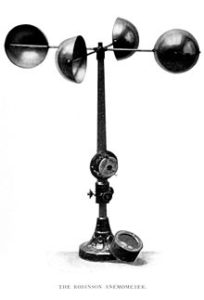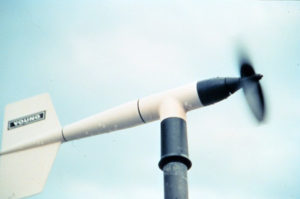 An anemometer is a weather monitor instrument used to measure wind speed. The first crude anemometers were used to roughly measure wind speed hundreds of years ago, but today anemometers are highly accurate wind speed monitors that can provide data in a variety of ways.
An anemometer is a weather monitor instrument used to measure wind speed. The first crude anemometers were used to roughly measure wind speed hundreds of years ago, but today anemometers are highly accurate wind speed monitors that can provide data in a variety of ways.
How do anemometers work to monitor wind speed?
There are several different types of anemometers and each one functions slightly differently. How an individual anemometer works to measure wind speed and sometimes direction is based on what type it is.
For instance, here is an example of a popular handheld anemometer:
Ambient Weather WM-5 Handheld Weather Station
Ambient Weather makes some of the best portable anemometers for the money. If you need more features than just wind speed and temperature, consider this portable weather station. It takes the same readings as basic anemometers but it adds in the ability to detect exact wind direction with its directional compass as well as humidity, and heat index, dew point measurements, and more. It can calculate cross winds, head winds, tail winds, and gusts too. This is also a rugged unit; it’s water resistant and it floats. Accurate from -20 to 158F (-28-70C) and 0.8-90 miles per hour. Uses one coin style Lithium battery (included).
Measures: 5.9 inches long x 2.1 inches wide x 0.85 inches thick
Weighs: 181g / 0.4 lbs
Below we’ll list the major types of modern anemometers that you will commonly find today.
How cup anemometers work
Cup anemometers are perhaps the most simple type of anemometer, and among the most accurate. They are mounted on a pole with and consist of a set of two, three or four spinning cups which blow in the wind. Generally speaking three cup anemometers are the most common type these days. As the wind gets stronger, the cup formation spins faster and the anemometer captures the speed of the air flow and displays it as a digital readout. Cup anemometers are commonly used today by professional weather stations to measure wind speed.
Most cup anemometers are meant to be mounted on either a building or a sailboat but there are some handheld cup anemometers that do exist.
For more, see our article about the best cup anemometers and how cup anemometers work.
Related: What is the Best Wireless Anemometer & Wireless Wind Speed Meter?
How vane anemometers work

Another one of the types of anemometer are vane anemometers. They’re also known as propeller or windmill anemometers, are similar to the cup anemometer however instead of spinning cups they instead use an array of wind blades that turn. They are not mounted vertically like the cup anemometers and instead the blades are horizontally mounted and face into the wind. Vane anemometers must rotate to face in whatever direction the wind is blowing so they often use a wind vane opposite the propeller to shift in the direction of the wind. Like cup anemometers, vane anemometers or propeller anemometers automatically count the number of revolutions per second to calculate wind speed and display that digitally for you. Some handheld propeller anemometers are also called impeller wind monitors because their propeller blades are protected by a caging unit to make sure they don’t get caught on your hand.
Some vane anemometers are meant to be mounted on buildings but handheld vane anemometers are also quite common.
How hot-wire anemometers work
Hot-wire anemometers or constant current anemometers work by heating a thin wire to a specific temperature and then measuring how much the wire is cooled by the air flow. The hot wire anemometer is able to calculate how fast the wind is blowing by measuring how quickly the wire cools down and how cool it gets.
Hot wire anemometers are most commonly made for handheld usage.
What is the best type of anemometer?
There really isn’t a best type of anemometer. Each type of wind speed monitor works slightly differently and may be better for some uses than others. For instance, if you’re looking for a portable handheld wind speed monitor, you might want to consider a vane anemometer (propeller wind speed meter) or a hot wire anemometer because a cup anemometer might be a bit too bulky to carry around since the cups stick out.
Alternatively if you want to mount an anemometer at your house to measure the wind speed outdoors you’re probably better off with either a cup anemometer or a vane anemometer since hot-wire anemometers are generally meant for handheld usage. In very light wind, vane anemometers might not work quite as well as cup anemometers simply because they need the wind to be strong enough to point their vane in the direction they’re blowing. However cup anemometers won’t give you data on the direction the wind is blowing, as vane anemometers typically will.
Additionally, if you’re planning to affix a wind speed sensor or anemometer on the outside of your home as part of a home weather station, you may want to choose which type of anemometer to use based on size or aesthetic concerns as well.
Specialty Anemometers for indoor and outdoor usage
Anemometers come with different uses in mind but most handheld wind speed monitors are fairly rugged and most mountable anemometers tend to be weatherproof.
Some anemometers are easy to take with you wherever you go, and others come as part of wireless weather stations that you can place in your backyard and read off an indoor monitor. Additionally some handheld anemometers are compact for portable use and others have long cables for mounting purposes. Still others are designed to be mounted on boats. Some anemometers are better for HVAC installation or repair uses and others still like hot wire air velocity meters are great for measuring the air flow that may be coming in from a drafty door or window. Many anemometers today connect to an app on your smartphone or tablet as well.
Who made the first anemometer?
Anemometers, or wind speed meters, have been around for hundreds of years. Italian inventor Leon Battista Alberti is said to have invented the first anemometer in 1450. Read more about the history of the anemometer at Wikipedia.
Who uses anemometers and why?
Plenty of people use anemometers for both professional and hobby uses. Here are some examples of why a person might need an anemometer.
Common uses of an anemometer include:
- Someone with a sailboat who wants to measure wind speed before they go sailing or windspeed and direction during sailing
- A windsurfer who wants to monitor wind conditions
- Weather enthusiasts and hobbyists
- HVAC installation and repair personnel wanting a scientific way to measure airflow in an air conditioning, heating or ventilation unit or home inspectors and facility managers
- People who live in rural areas that don’t have reliable or accurate weather data that want to set up their own personal weather station
- People who fly drones or RC planes that want to check weather conditions to see if it’s safe to fly
- Scientists who measure environmental conditions
- Hunters, sports shooters/target shooters and archers (as well as those in the military) wanting a quick way to check ground conditions or wind direction and speed (See our related article: The best wind meters for long range shooting)
- Kite flyers or paragliders who want to check conditions before launching
- Safari guides who want to keep an eye on wind conditions and staying downwind of various exotic animals
